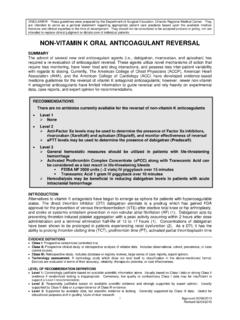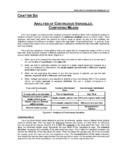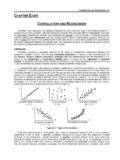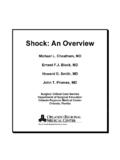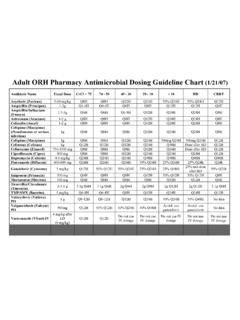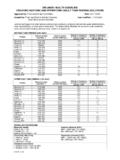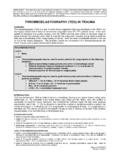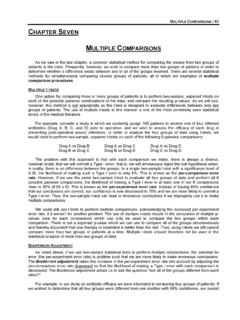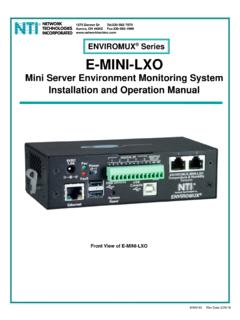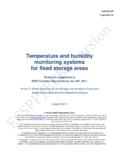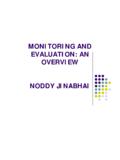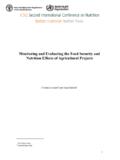Transcription of hemodynamic monitoring principles to practice
1 hemodynamic monitoring : principles to practice M. L. Cheatham, MD, FACS, FCCM. SUMMARY. Fluid- Fluid-filled catheters are commonly utilized in the ICU to measure a variety of physiologic parameters Systemic blood pressures Pulmonary blood pressures Intra Intra--abdominal pressure hemodynamic monitoring : monitoring . Intracranial pressure FROM principles TO practice . To appropriately assess and utilize the data provided by such monitoring devices, certain basic Michael L. Cheatham, MD, FACS, FCCM concepts must be understood Director, Surgical Intensive Care Units Orlando Regional Medical Center Orlando, Florida INTRODUCTION INTRODUCTION. Invasive pressure monitoring in the critically ill To improve patient outcome, accurate measurement provides valuable information of physiologic variables requires: Most accurate method for determining blood Constant vigilance to ensure accuracy pressure Thorough understanding of monitoring Allows continuous p physiologic y g monitoring g principles p p and pitfalls p Identifies physiologic abnormalities Appropriate application of information gained Can be used to guide appropriate resuscitative therapies WARNING: Physics lies up ahead!
2 If you developed Waveform interpretation provides valuable PTSD following college physics, you may want to information on the patient's cardiac contractility skip the remainder of this lecture (relax, it's actually and heart valve competency pretty cool and explains why you needed to take physics after all). G-I-G-O MEASURING PRESSURE VARIABLES. Each fluid fluid--based pressure monitoring system has Garbage In Garbage Out . the following components Erroneous physiologic measurements can result Intravascular catheter in inappropriate patient therapy Connecting tubing and stopcocks Hydraulic You should always ask Is this data valid? . Pressure transducer system Example E l Continuous flush device Diebel et al. found that 52% of PAOP. measurements in surgical patients are Amplifier inaccurate and misleading as a result of Oscilloscope / Digital display Electronic monitoring artifacts Processor system Reliance upon erroneous PAOP and CVP values Recorder to resuscitate critically ill patients may lead to under--resuscitation and inappropriate therapy under Revised 01/13/2009 1.
3 hemodynamic monitoring : principles to practice M. L. Cheatham, MD, FACS, FCCM. MEASURING PRESSURE VARIABLES HYDRAULIC SYSTEM COMPONENTS. The hydraulic system is much more subject to Intravascular catheter potential errors and artifacts than is the electronic Tubing to access the desired blood vessel or system compartment Learning to troubleshoot the hydraulic portion of a Detects the pressure waves generated by cardiac invasive pressure monitoring system is essential contraction Confirms the validity of the data Connecting tubing and stopcocks Helps avoid inappropriate therapeutic Transmits pressure wave from patient to interventions based upon erroneous data measuring device Allows control of blood vessel to avoid hemorrhage, introduction of air, etc . PRESSURE TRANSDUCER WHEATSTONE BRIDGE.
4 Converts the mechanical impulse of a pressure wave An electrical circuit for into an electrical signal through movement of a strain comparison of resistances gauge . Consists of a power source and Modern transducers utilize a displaceable silicon four resistors, three of which sensing diaphragm and a Wheatstone Bridge have a known resistance To determine the unknown Transducer Dome Sensing Diaphragm resistance, the resistance of the other three are balanced until the current passing through both sides of the parallel bridge . decreases to zero Pressure Tubing Pressure Wave WHEATSTONE BRIDGE HYDRAULIC SYSTEM COMPONENTS. The Wheatstone Bridge is used to measure the Continuous flush device resistance change in a strain gauge Flushes the tubing with fluid The resistance change is proportional to the at a rate of 1- 1-3 mL/hr and changing physiologic variable ( pressure) or helps prevent blood from mechanical strain applied to the transducer clotting off the catheter Zeroing a transducer is simply determining the The fast flush feature value of the unknown resistance at rest increases the flow to 30.
5 Balancing the bridge mL/min and can be used to As the physiologic variable changes, the test the system's compliance resistance varies proportionally, a current is induced across the bridge, and the voltmeter value is converted to a pressure measurement Revised 01/13/2009 2. hemodynamic monitoring : principles to practice M. L. Cheatham, MD, FACS, FCCM. ELECTRONIC SYSTEM COMPONENTS MEASURING PRESSURE VARIABLES. Amplifier Increases the low voltage signal from the pressure transducer to a signal that can be displayed Most include electronic filters to remove unwanted SIGNAL. PRESSURE AMPLIFIER & SIGNAL ANALOG TO DIGITAL. TRANSDUCER CONDITIONING CONVERTER. physiologic p y g noise . Oscilloscope / Digital display Used to display waveforms and numerical data STRIP RECORDER BEDSIDE MONITOR MICROPROCESSOR.
6 Processor Used to calculate various hemodynamic parameters Recorder A printer, strip chart recorder, or other device TYPICAL RADIAL ARTERY PRESSURE. monitoring SYSTEM CLINICAL CORRELATION. What do these measurements mean clinically? Systolic pressure The pressure exerted on the artery walls due to left ventricular contraction ( , contractility). Diastolic pressure The pressure exerted during left ventricular relaxation ( , vascular resistance). Pulse pressure The difference between peak systolic and diastolic pressures ( , perfusion). CLINICAL CORRELATION PHYSICS OF PRESSURE monitoring . What do these measurements mean clinically? The typical catheter catheter--transducer system in the ICU is Dicrotic notch pressure considered to be a second- second-order dynamic system . The pressure that The pressure waveform dampens over time reflects aortic valve Determined by two factors closure Natural Natural frequency.
7 Frequency Heart rate The number of oscillations per unit time that The frequency of occurs without any damping contraction measured Damping coefficient . in beats per minute The time taken to dampen the waveform Ejection time The time of left ventricular ejection Revised 01/13/2009 3. hemodynamic monitoring : principles to practice M. L. Cheatham, MD, FACS, FCCM. PHYSICS OF PRESSURE monitoring PHYSICS OF PRESSURE monitoring . For example, when dropped onto a hard floor, a ball However, if the same ball is dropped onto soft earth, bounces several times before coming to rest the ball will not bounce as high, resulting in a With each successive bounce, it does not rise as decreased frequency, and will come to rest sooner, high as on the previous bounce reflecting an increased damping coefficient Each bounce has a characteristic frequency q y ((the This can be expressed mathematically BUT you number of oscillations per unit time) and don't need to know how to calculate it.)
8 Damping coefficient (time that it takes the ball to P2 1. come to a rest) =. P1 f2 f + 2 j +1. Frequency Fn2 Fn P1, P2 are output and input signals of the pressure transducer respectively, f is an arbitrary frequency, Fn is the natural frequency, Damping Coefficient is the damping coefficient, and j is the complex number DETERMINING THE NATURAL FREQUENCY. PHYSICS OF PRESSURE monitoring AND DAMPING COEFFICIENT. The accuracy of a second second--order system is subject to This can also be expressed mathematically BUT. three mechanical factors you don't need to know how to calculate it . 1. Compliance The stiffness of the fluid fluid--filled system (tubing). 2. Fluid inertia 1 R C. The pressure required to move fluid (blood) Fn = =. through the system 2 IC 2 I. 3. Fluid resistance The viscosity of the fluid moving through the system (resistance due to friction) Fn is the natural frequency, is the damping coefficient, C = compliance, I = inertia, and R = resistance PHYSICS OF PRESSURE monitoring PHYSICS OF PRESSURE monitoring .
9 The complex pressure wave generated with each If the waveform is reflected off a transducer or other beat of the heart is not unlike the bouncing ball obstruction within the catheter catheter--tubing system, a A pressure waveform is propagated at a given wave reflection or harmonic is generated frequency (beats per minute) These harmonic waveforms are additive and can The vascular resistance acts as the damping p g introduce error into pressure measurements coefficient and diminishes the waveform's energy and magnitude over time The resulting arterial sine wave, occurring at the rate of the patient's pulse, is called the first harmonic or fundamental Revised 01/13/2009 4. hemodynamic monitoring : principles to practice M. L. Cheatham, MD, FACS, FCCM. PHYSICS OF PRESSURE monitoring UNDERDAMPED WAVEFORM.
10 Without some degree of damping within a system, Note the characteristic pressure waves reverberate within the catheter and narrow, peaked waveform tubing leading to the formation of harmonics and Overestimates systolic overestimation of true blood pressure and underestimates An underdamped underdamped system diastolic blood pressure With too much damping, the frictional forces impede Mean arterial pressure the arterial waveform such that it loses energy remains unchanged! leading to underestimation of blood pressure Causes An overdamped overdamped system Long stiff tubing, increased vascular resistance OVERDAMPED WAVEFORM OPTIMAL DAMPING. Note the characteristic widened Some damping is essential and slurred waveform to avoid harmonics Underestimates systolic The optimal amount of and overestimates diastolic damping is crucial to blood pressure accurate measurement Mean M arterial i l pressure of physiologic pressures remains unchanged!
